Cost-Benefit Analysis in Construction
VerifiedAdded on 2020/05/28
|6
|1579
|25
AI Summary
The assignment delves into the significance of cost-benefit analysis in evaluating the financial viability of proposed construction projects. It emphasizes the factors influencing project costs, benefits, and the limitations associated with traditional cost-benefit analysis techniques. The discussion highlights the challenges of accurately forecasting costs and benefits, subjectivity in valuation, and the impact of discount rates on present value calculations. Ultimately, the assignment stresses the importance of a comprehensive cost-benefit analysis for informed decision-making in the construction industry.
Contribute Materials
Your contribution can guide someone’s learning journey. Share your
documents today.
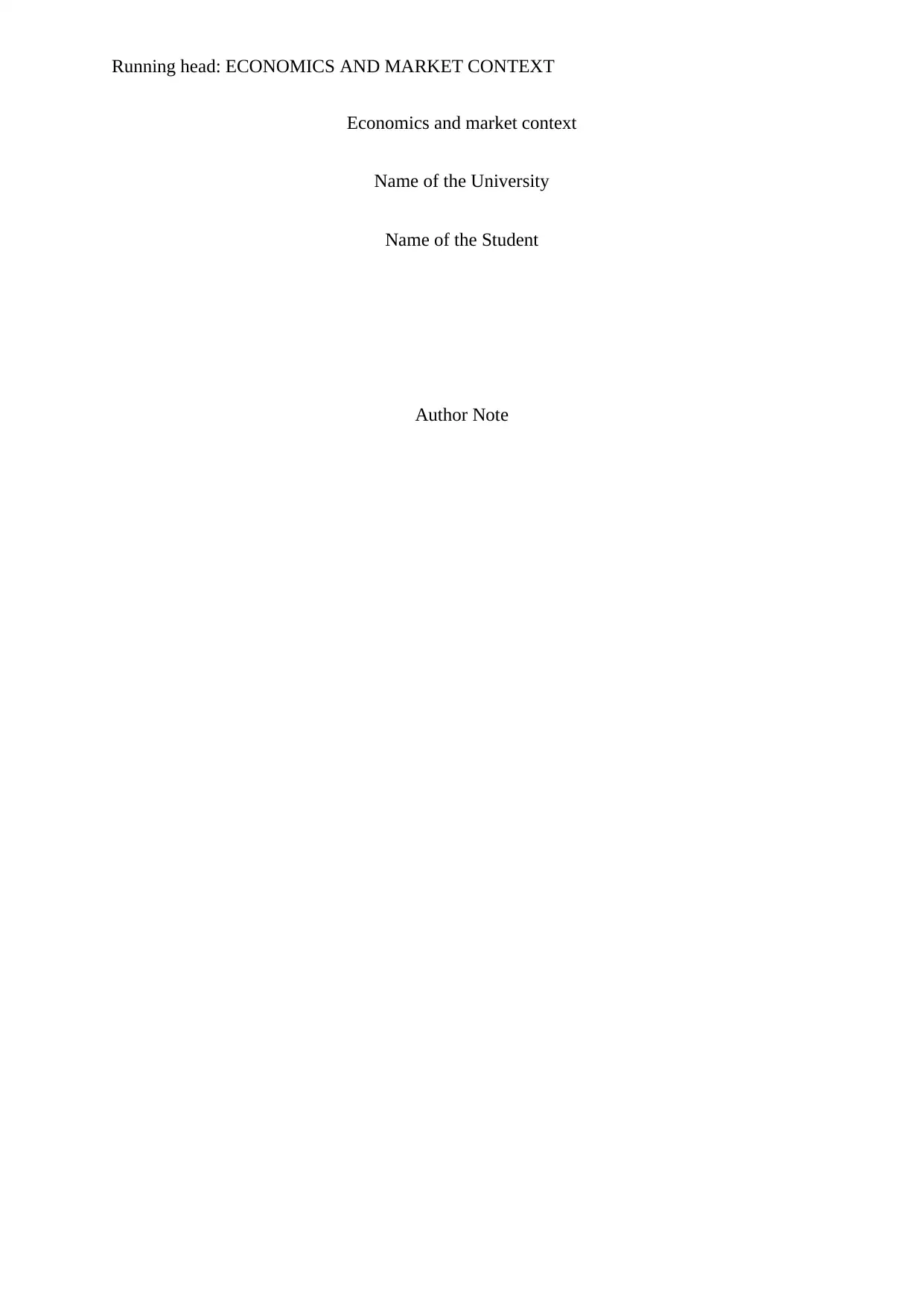
Running head: ECONOMICS AND MARKET CONTEXT
Economics and market context
Name of the University
Name of the Student
Author Note
Economics and market context
Name of the University
Name of the Student
Author Note
Secure Best Marks with AI Grader
Need help grading? Try our AI Grader for instant feedback on your assignments.
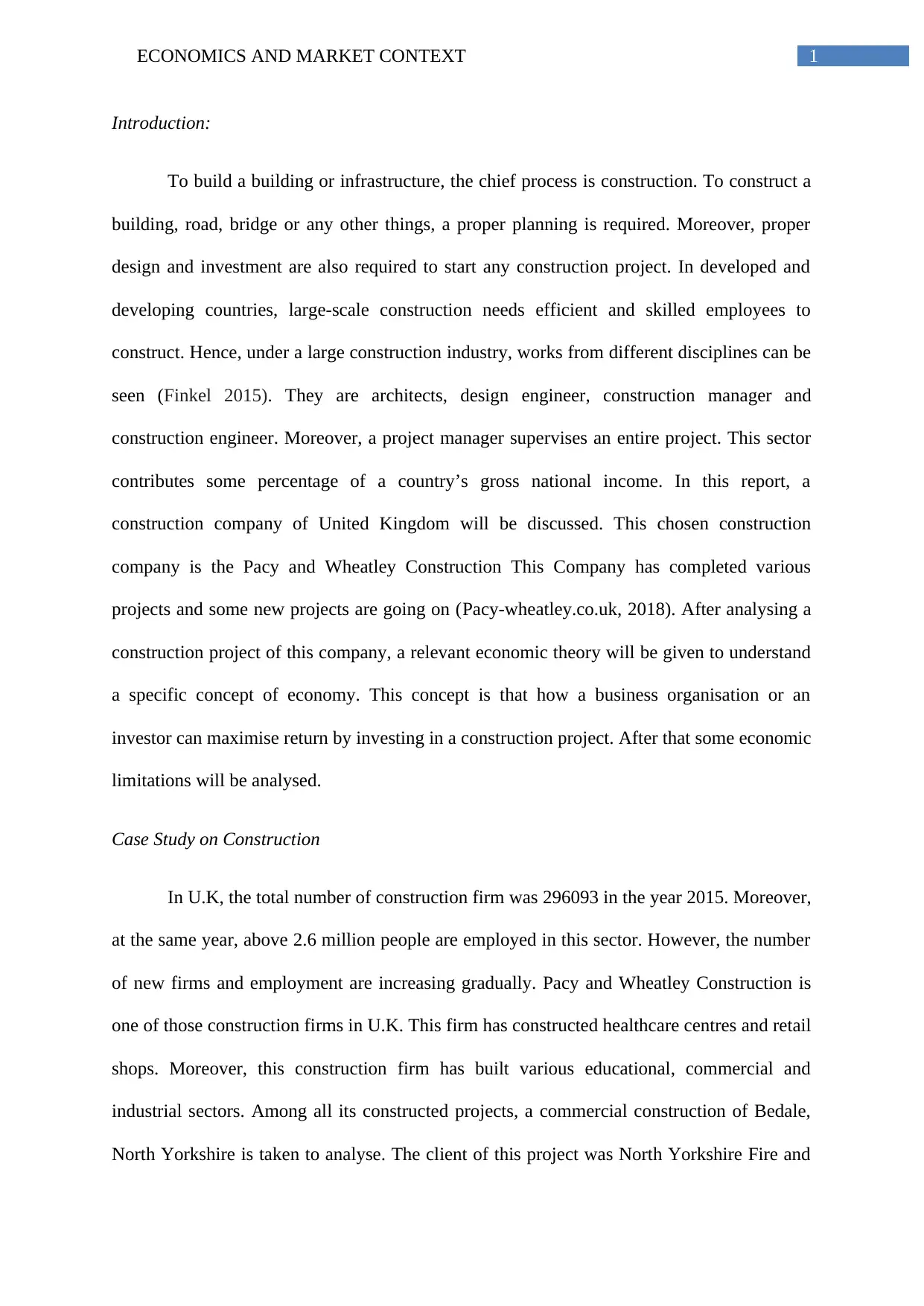
1ECONOMICS AND MARKET CONTEXT
Introduction:
To build a building or infrastructure, the chief process is construction. To construct a
building, road, bridge or any other things, a proper planning is required. Moreover, proper
design and investment are also required to start any construction project. In developed and
developing countries, large-scale construction needs efficient and skilled employees to
construct. Hence, under a large construction industry, works from different disciplines can be
seen (Finkel 2015). They are architects, design engineer, construction manager and
construction engineer. Moreover, a project manager supervises an entire project. This sector
contributes some percentage of a country’s gross national income. In this report, a
construction company of United Kingdom will be discussed. This chosen construction
company is the Pacy and Wheatley Construction This Company has completed various
projects and some new projects are going on (Pacy-wheatley.co.uk, 2018). After analysing a
construction project of this company, a relevant economic theory will be given to understand
a specific concept of economy. This concept is that how a business organisation or an
investor can maximise return by investing in a construction project. After that some economic
limitations will be analysed.
Case Study on Construction
In U.K, the total number of construction firm was 296093 in the year 2015. Moreover,
at the same year, above 2.6 million people are employed in this sector. However, the number
of new firms and employment are increasing gradually. Pacy and Wheatley Construction is
one of those construction firms in U.K. This firm has constructed healthcare centres and retail
shops. Moreover, this construction firm has built various educational, commercial and
industrial sectors. Among all its constructed projects, a commercial construction of Bedale,
North Yorkshire is taken to analyse. The client of this project was North Yorkshire Fire and
Introduction:
To build a building or infrastructure, the chief process is construction. To construct a
building, road, bridge or any other things, a proper planning is required. Moreover, proper
design and investment are also required to start any construction project. In developed and
developing countries, large-scale construction needs efficient and skilled employees to
construct. Hence, under a large construction industry, works from different disciplines can be
seen (Finkel 2015). They are architects, design engineer, construction manager and
construction engineer. Moreover, a project manager supervises an entire project. This sector
contributes some percentage of a country’s gross national income. In this report, a
construction company of United Kingdom will be discussed. This chosen construction
company is the Pacy and Wheatley Construction This Company has completed various
projects and some new projects are going on (Pacy-wheatley.co.uk, 2018). After analysing a
construction project of this company, a relevant economic theory will be given to understand
a specific concept of economy. This concept is that how a business organisation or an
investor can maximise return by investing in a construction project. After that some economic
limitations will be analysed.
Case Study on Construction
In U.K, the total number of construction firm was 296093 in the year 2015. Moreover,
at the same year, above 2.6 million people are employed in this sector. However, the number
of new firms and employment are increasing gradually. Pacy and Wheatley Construction is
one of those construction firms in U.K. This firm has constructed healthcare centres and retail
shops. Moreover, this construction firm has built various educational, commercial and
industrial sectors. Among all its constructed projects, a commercial construction of Bedale,
North Yorkshire is taken to analyse. The client of this project was North Yorkshire Fire and
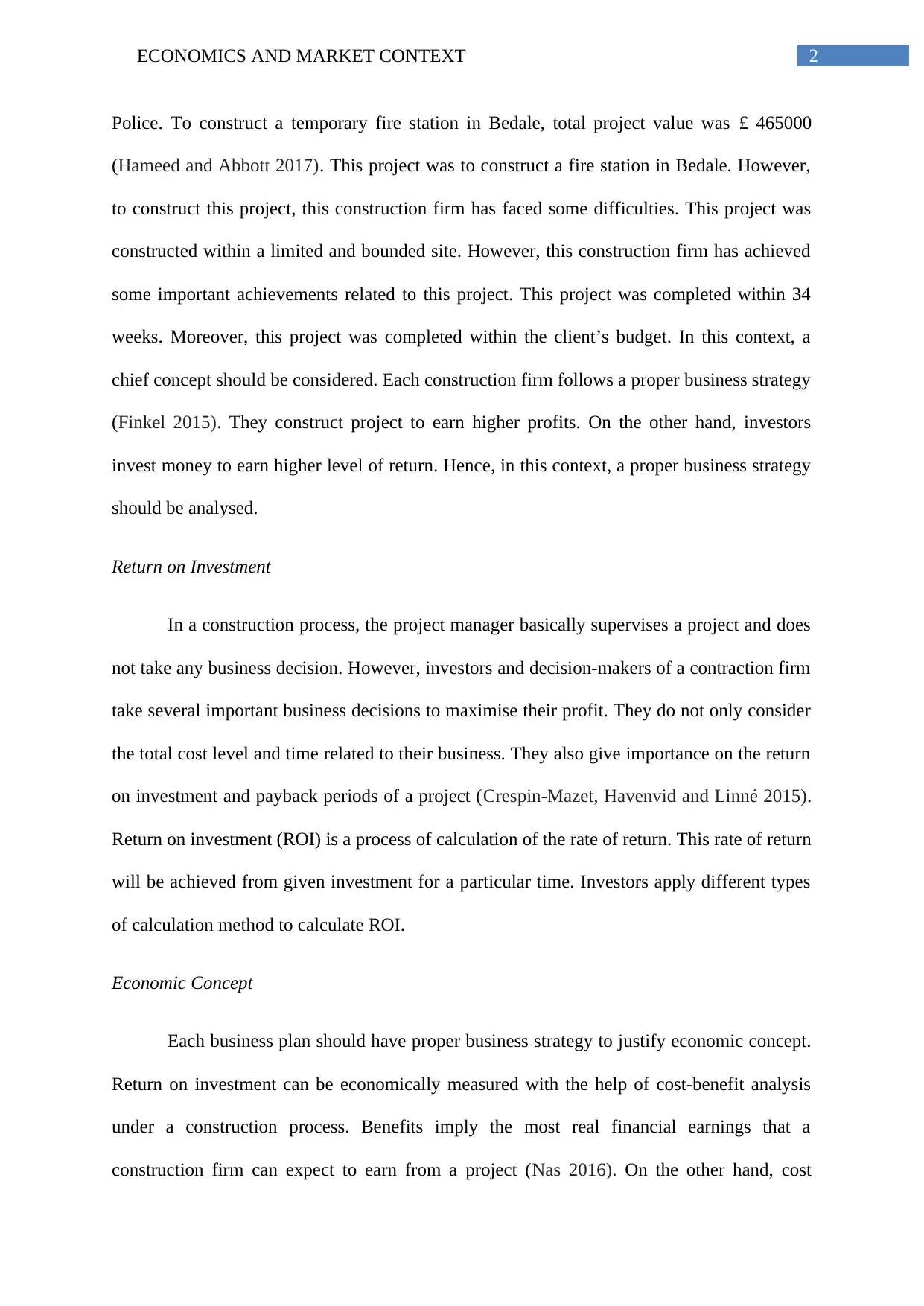
2ECONOMICS AND MARKET CONTEXT
Police. To construct a temporary fire station in Bedale, total project value was £ 465000
(Hameed and Abbott 2017). This project was to construct a fire station in Bedale. However,
to construct this project, this construction firm has faced some difficulties. This project was
constructed within a limited and bounded site. However, this construction firm has achieved
some important achievements related to this project. This project was completed within 34
weeks. Moreover, this project was completed within the client’s budget. In this context, a
chief concept should be considered. Each construction firm follows a proper business strategy
(Finkel 2015). They construct project to earn higher profits. On the other hand, investors
invest money to earn higher level of return. Hence, in this context, a proper business strategy
should be analysed.
Return on Investment
In a construction process, the project manager basically supervises a project and does
not take any business decision. However, investors and decision-makers of a contraction firm
take several important business decisions to maximise their profit. They do not only consider
the total cost level and time related to their business. They also give importance on the return
on investment and payback periods of a project (Crespin-Mazet, Havenvid and Linné 2015).
Return on investment (ROI) is a process of calculation of the rate of return. This rate of return
will be achieved from given investment for a particular time. Investors apply different types
of calculation method to calculate ROI.
Economic Concept
Each business plan should have proper business strategy to justify economic concept.
Return on investment can be economically measured with the help of cost-benefit analysis
under a construction process. Benefits imply the most real financial earnings that a
construction firm can expect to earn from a project (Nas 2016). On the other hand, cost
Police. To construct a temporary fire station in Bedale, total project value was £ 465000
(Hameed and Abbott 2017). This project was to construct a fire station in Bedale. However,
to construct this project, this construction firm has faced some difficulties. This project was
constructed within a limited and bounded site. However, this construction firm has achieved
some important achievements related to this project. This project was completed within 34
weeks. Moreover, this project was completed within the client’s budget. In this context, a
chief concept should be considered. Each construction firm follows a proper business strategy
(Finkel 2015). They construct project to earn higher profits. On the other hand, investors
invest money to earn higher level of return. Hence, in this context, a proper business strategy
should be analysed.
Return on Investment
In a construction process, the project manager basically supervises a project and does
not take any business decision. However, investors and decision-makers of a contraction firm
take several important business decisions to maximise their profit. They do not only consider
the total cost level and time related to their business. They also give importance on the return
on investment and payback periods of a project (Crespin-Mazet, Havenvid and Linné 2015).
Return on investment (ROI) is a process of calculation of the rate of return. This rate of return
will be achieved from given investment for a particular time. Investors apply different types
of calculation method to calculate ROI.
Economic Concept
Each business plan should have proper business strategy to justify economic concept.
Return on investment can be economically measured with the help of cost-benefit analysis
under a construction process. Benefits imply the most real financial earnings that a
construction firm can expect to earn from a project (Nas 2016). On the other hand, cost
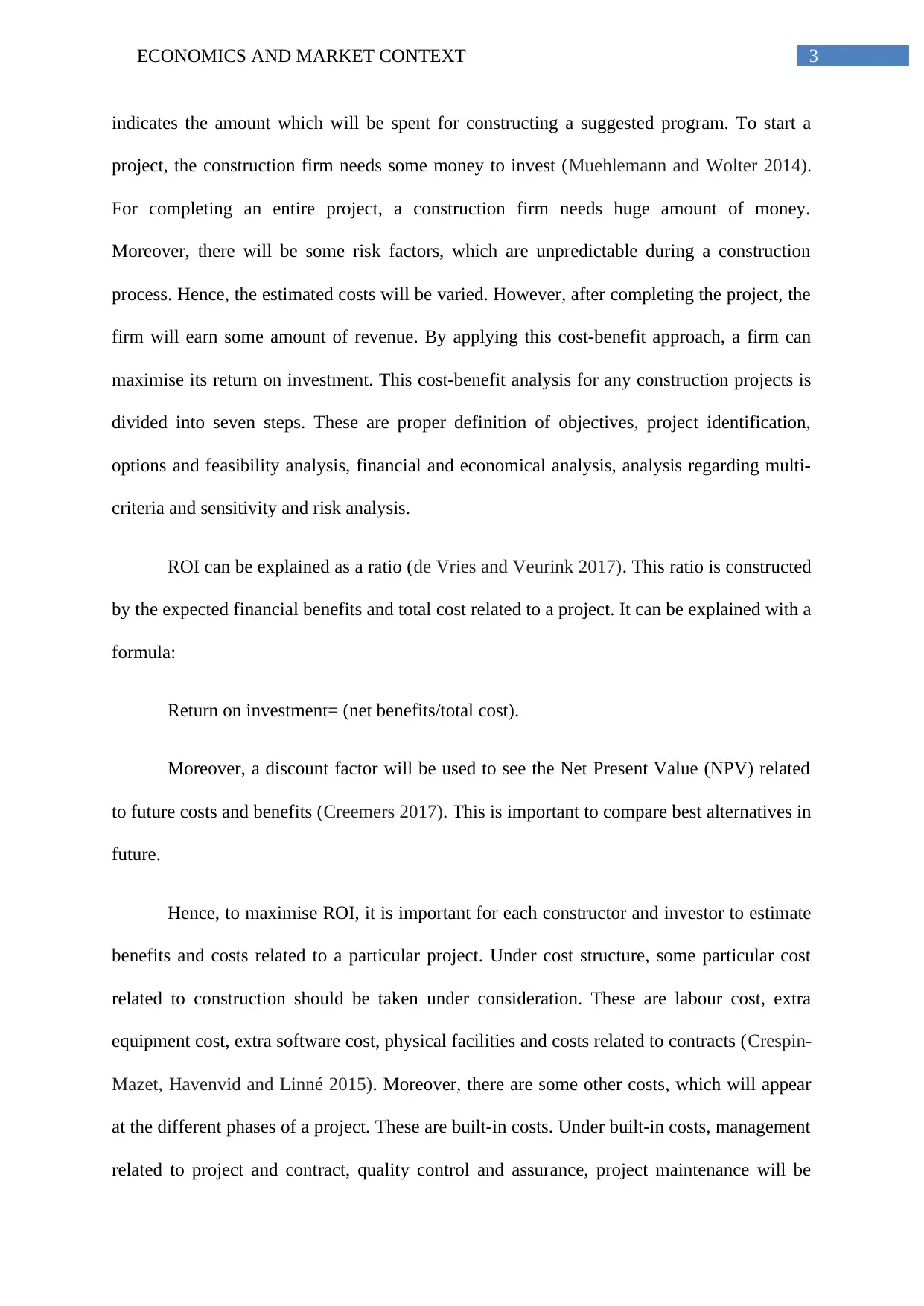
3ECONOMICS AND MARKET CONTEXT
indicates the amount which will be spent for constructing a suggested program. To start a
project, the construction firm needs some money to invest (Muehlemann and Wolter 2014).
For completing an entire project, a construction firm needs huge amount of money.
Moreover, there will be some risk factors, which are unpredictable during a construction
process. Hence, the estimated costs will be varied. However, after completing the project, the
firm will earn some amount of revenue. By applying this cost-benefit approach, a firm can
maximise its return on investment. This cost-benefit analysis for any construction projects is
divided into seven steps. These are proper definition of objectives, project identification,
options and feasibility analysis, financial and economical analysis, analysis regarding multi-
criteria and sensitivity and risk analysis.
ROI can be explained as a ratio (de Vries and Veurink 2017). This ratio is constructed
by the expected financial benefits and total cost related to a project. It can be explained with a
formula:
Return on investment= (net benefits/total cost).
Moreover, a discount factor will be used to see the Net Present Value (NPV) related
to future costs and benefits (Creemers 2017). This is important to compare best alternatives in
future.
Hence, to maximise ROI, it is important for each constructor and investor to estimate
benefits and costs related to a particular project. Under cost structure, some particular cost
related to construction should be taken under consideration. These are labour cost, extra
equipment cost, extra software cost, physical facilities and costs related to contracts (Crespin-
Mazet, Havenvid and Linné 2015). Moreover, there are some other costs, which will appear
at the different phases of a project. These are built-in costs. Under built-in costs, management
related to project and contract, quality control and assurance, project maintenance will be
indicates the amount which will be spent for constructing a suggested program. To start a
project, the construction firm needs some money to invest (Muehlemann and Wolter 2014).
For completing an entire project, a construction firm needs huge amount of money.
Moreover, there will be some risk factors, which are unpredictable during a construction
process. Hence, the estimated costs will be varied. However, after completing the project, the
firm will earn some amount of revenue. By applying this cost-benefit approach, a firm can
maximise its return on investment. This cost-benefit analysis for any construction projects is
divided into seven steps. These are proper definition of objectives, project identification,
options and feasibility analysis, financial and economical analysis, analysis regarding multi-
criteria and sensitivity and risk analysis.
ROI can be explained as a ratio (de Vries and Veurink 2017). This ratio is constructed
by the expected financial benefits and total cost related to a project. It can be explained with a
formula:
Return on investment= (net benefits/total cost).
Moreover, a discount factor will be used to see the Net Present Value (NPV) related
to future costs and benefits (Creemers 2017). This is important to compare best alternatives in
future.
Hence, to maximise ROI, it is important for each constructor and investor to estimate
benefits and costs related to a particular project. Under cost structure, some particular cost
related to construction should be taken under consideration. These are labour cost, extra
equipment cost, extra software cost, physical facilities and costs related to contracts (Crespin-
Mazet, Havenvid and Linné 2015). Moreover, there are some other costs, which will appear
at the different phases of a project. These are built-in costs. Under built-in costs, management
related to project and contract, quality control and assurance, project maintenance will be
Secure Best Marks with AI Grader
Need help grading? Try our AI Grader for instant feedback on your assignments.
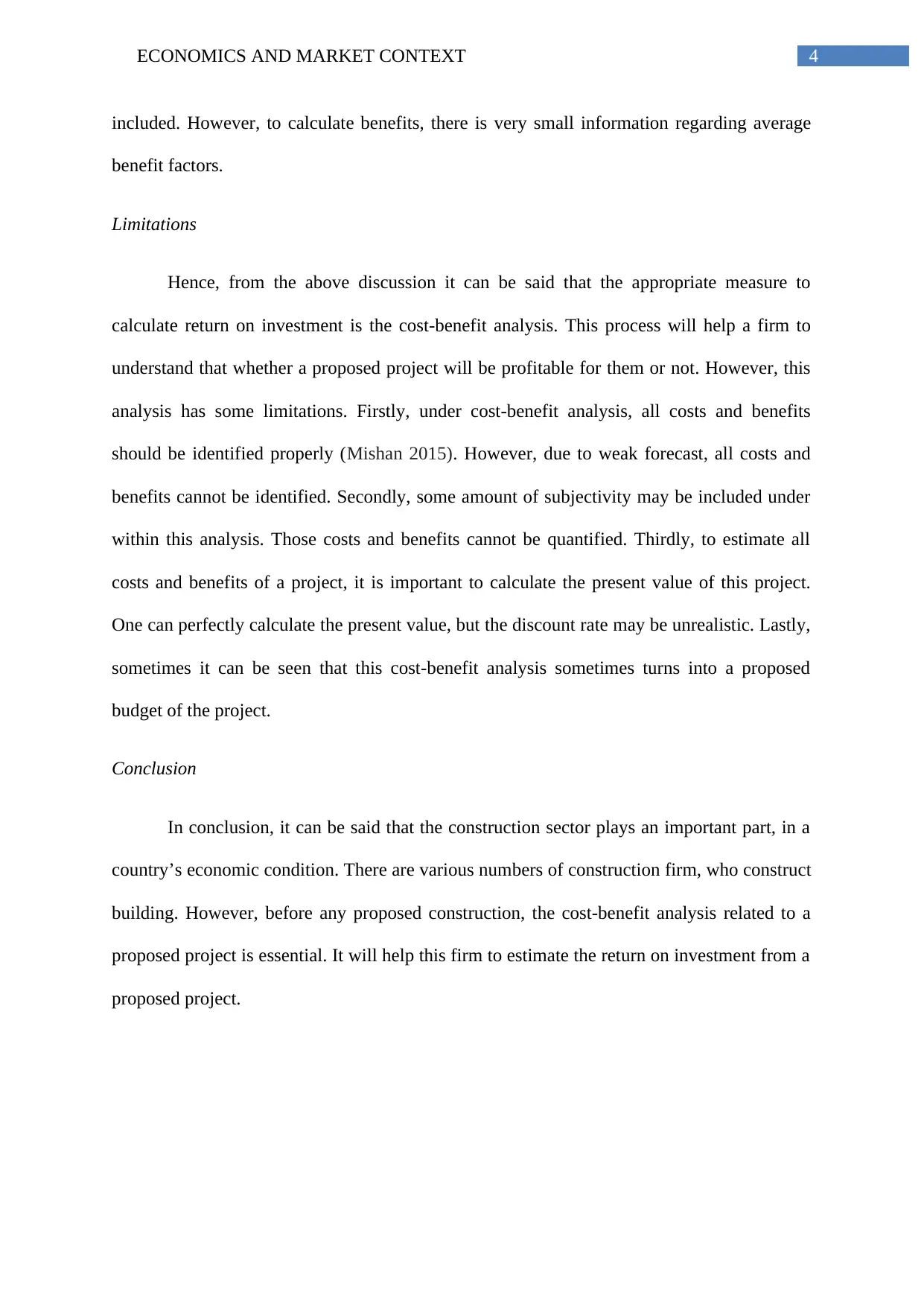
4ECONOMICS AND MARKET CONTEXT
included. However, to calculate benefits, there is very small information regarding average
benefit factors.
Limitations
Hence, from the above discussion it can be said that the appropriate measure to
calculate return on investment is the cost-benefit analysis. This process will help a firm to
understand that whether a proposed project will be profitable for them or not. However, this
analysis has some limitations. Firstly, under cost-benefit analysis, all costs and benefits
should be identified properly (Mishan 2015). However, due to weak forecast, all costs and
benefits cannot be identified. Secondly, some amount of subjectivity may be included under
within this analysis. Those costs and benefits cannot be quantified. Thirdly, to estimate all
costs and benefits of a project, it is important to calculate the present value of this project.
One can perfectly calculate the present value, but the discount rate may be unrealistic. Lastly,
sometimes it can be seen that this cost-benefit analysis sometimes turns into a proposed
budget of the project.
Conclusion
In conclusion, it can be said that the construction sector plays an important part, in a
country’s economic condition. There are various numbers of construction firm, who construct
building. However, before any proposed construction, the cost-benefit analysis related to a
proposed project is essential. It will help this firm to estimate the return on investment from a
proposed project.
included. However, to calculate benefits, there is very small information regarding average
benefit factors.
Limitations
Hence, from the above discussion it can be said that the appropriate measure to
calculate return on investment is the cost-benefit analysis. This process will help a firm to
understand that whether a proposed project will be profitable for them or not. However, this
analysis has some limitations. Firstly, under cost-benefit analysis, all costs and benefits
should be identified properly (Mishan 2015). However, due to weak forecast, all costs and
benefits cannot be identified. Secondly, some amount of subjectivity may be included under
within this analysis. Those costs and benefits cannot be quantified. Thirdly, to estimate all
costs and benefits of a project, it is important to calculate the present value of this project.
One can perfectly calculate the present value, but the discount rate may be unrealistic. Lastly,
sometimes it can be seen that this cost-benefit analysis sometimes turns into a proposed
budget of the project.
Conclusion
In conclusion, it can be said that the construction sector plays an important part, in a
country’s economic condition. There are various numbers of construction firm, who construct
building. However, before any proposed construction, the cost-benefit analysis related to a
proposed project is essential. It will help this firm to estimate the return on investment from a
proposed project.
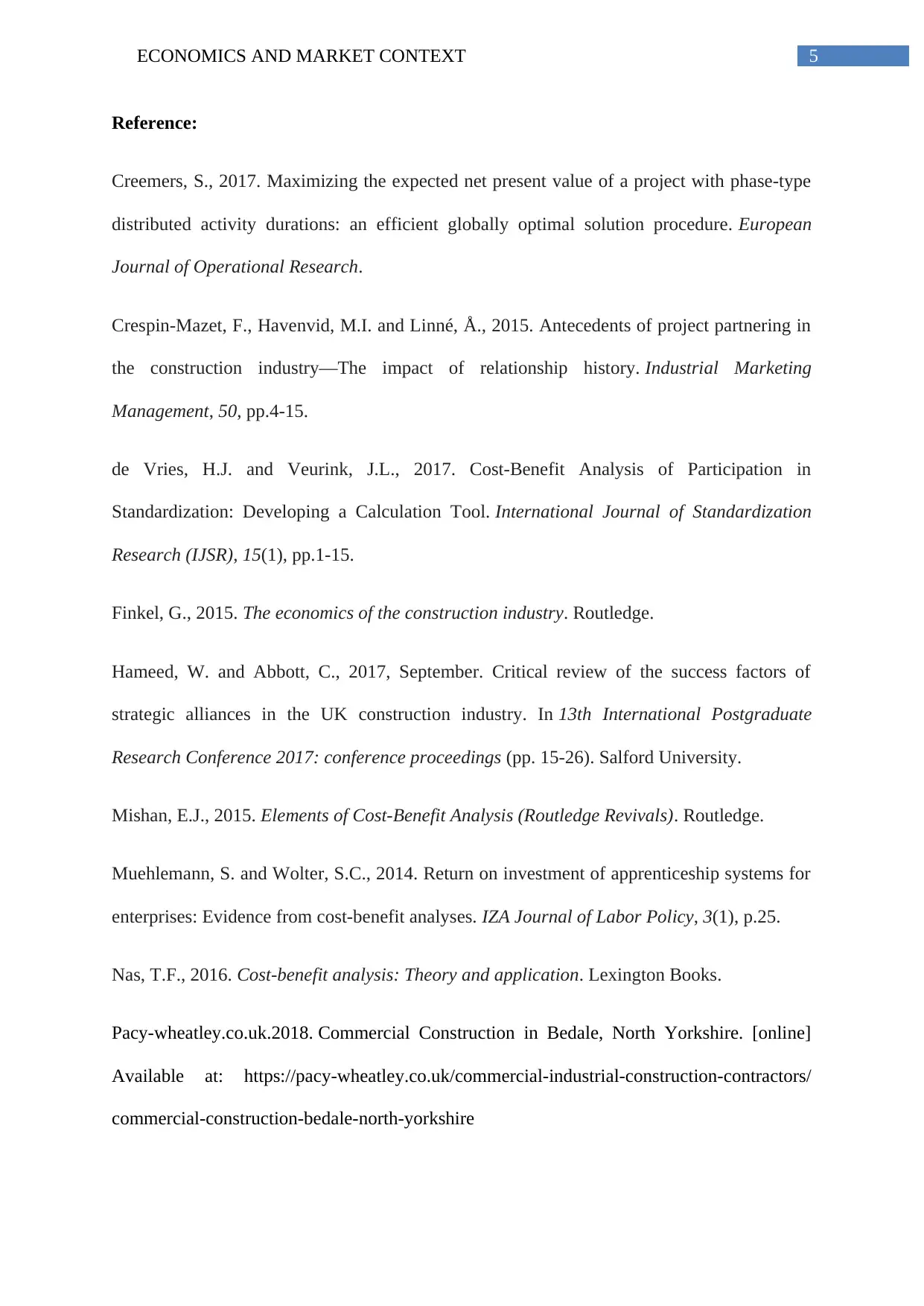
5ECONOMICS AND MARKET CONTEXT
Reference:
Creemers, S., 2017. Maximizing the expected net present value of a project with phase-type
distributed activity durations: an efficient globally optimal solution procedure. European
Journal of Operational Research.
Crespin-Mazet, F., Havenvid, M.I. and Linné, Å., 2015. Antecedents of project partnering in
the construction industry—The impact of relationship history. Industrial Marketing
Management, 50, pp.4-15.
de Vries, H.J. and Veurink, J.L., 2017. Cost-Benefit Analysis of Participation in
Standardization: Developing a Calculation Tool. International Journal of Standardization
Research (IJSR), 15(1), pp.1-15.
Finkel, G., 2015. The economics of the construction industry. Routledge.
Hameed, W. and Abbott, C., 2017, September. Critical review of the success factors of
strategic alliances in the UK construction industry. In 13th International Postgraduate
Research Conference 2017: conference proceedings (pp. 15-26). Salford University.
Mishan, E.J., 2015. Elements of Cost-Benefit Analysis (Routledge Revivals). Routledge.
Muehlemann, S. and Wolter, S.C., 2014. Return on investment of apprenticeship systems for
enterprises: Evidence from cost-benefit analyses. IZA Journal of Labor Policy, 3(1), p.25.
Nas, T.F., 2016. Cost-benefit analysis: Theory and application. Lexington Books.
Pacy-wheatley.co.uk.2018. Commercial Construction in Bedale, North Yorkshire. [online]
Available at: https://pacy-wheatley.co.uk/commercial-industrial-construction-contractors/
commercial-construction-bedale-north-yorkshire
Reference:
Creemers, S., 2017. Maximizing the expected net present value of a project with phase-type
distributed activity durations: an efficient globally optimal solution procedure. European
Journal of Operational Research.
Crespin-Mazet, F., Havenvid, M.I. and Linné, Å., 2015. Antecedents of project partnering in
the construction industry—The impact of relationship history. Industrial Marketing
Management, 50, pp.4-15.
de Vries, H.J. and Veurink, J.L., 2017. Cost-Benefit Analysis of Participation in
Standardization: Developing a Calculation Tool. International Journal of Standardization
Research (IJSR), 15(1), pp.1-15.
Finkel, G., 2015. The economics of the construction industry. Routledge.
Hameed, W. and Abbott, C., 2017, September. Critical review of the success factors of
strategic alliances in the UK construction industry. In 13th International Postgraduate
Research Conference 2017: conference proceedings (pp. 15-26). Salford University.
Mishan, E.J., 2015. Elements of Cost-Benefit Analysis (Routledge Revivals). Routledge.
Muehlemann, S. and Wolter, S.C., 2014. Return on investment of apprenticeship systems for
enterprises: Evidence from cost-benefit analyses. IZA Journal of Labor Policy, 3(1), p.25.
Nas, T.F., 2016. Cost-benefit analysis: Theory and application. Lexington Books.
Pacy-wheatley.co.uk.2018. Commercial Construction in Bedale, North Yorkshire. [online]
Available at: https://pacy-wheatley.co.uk/commercial-industrial-construction-contractors/
commercial-construction-bedale-north-yorkshire
1 out of 6
Your All-in-One AI-Powered Toolkit for Academic Success.
+13062052269
info@desklib.com
Available 24*7 on WhatsApp / Email
![[object Object]](/_next/static/media/star-bottom.7253800d.svg)
Unlock your academic potential
© 2024 | Zucol Services PVT LTD | All rights reserved.